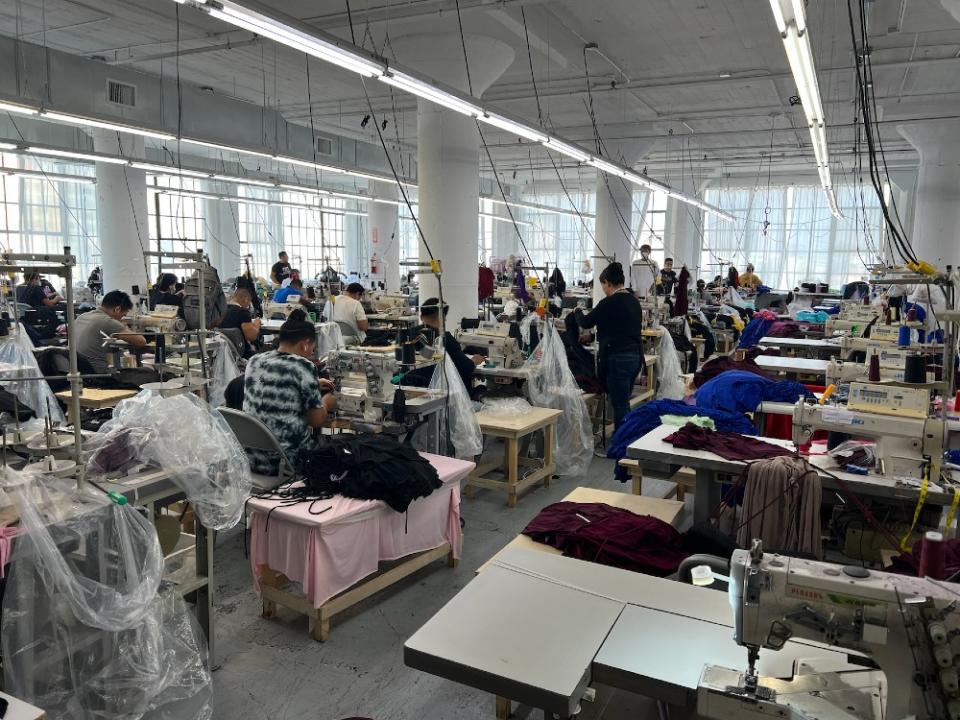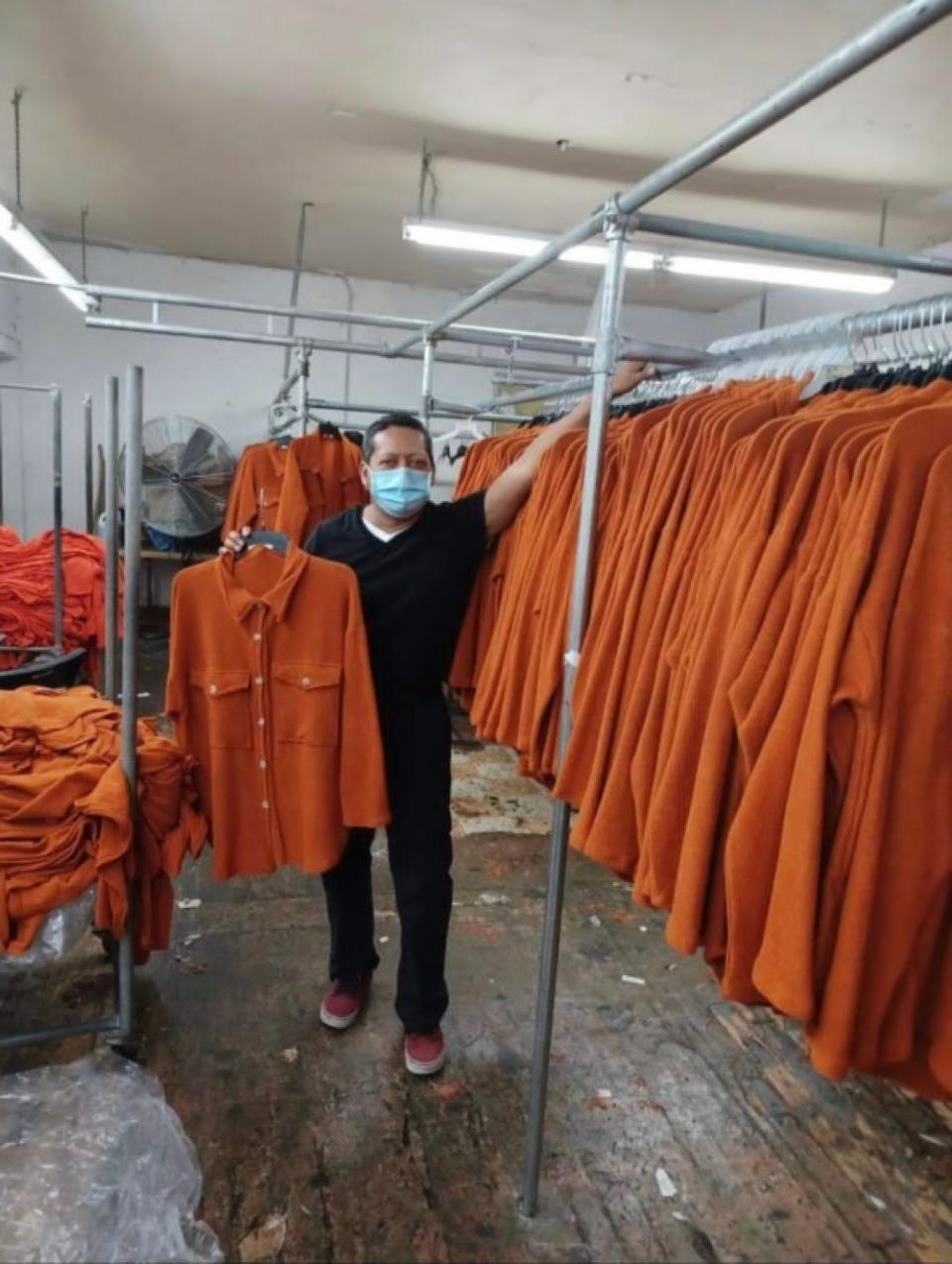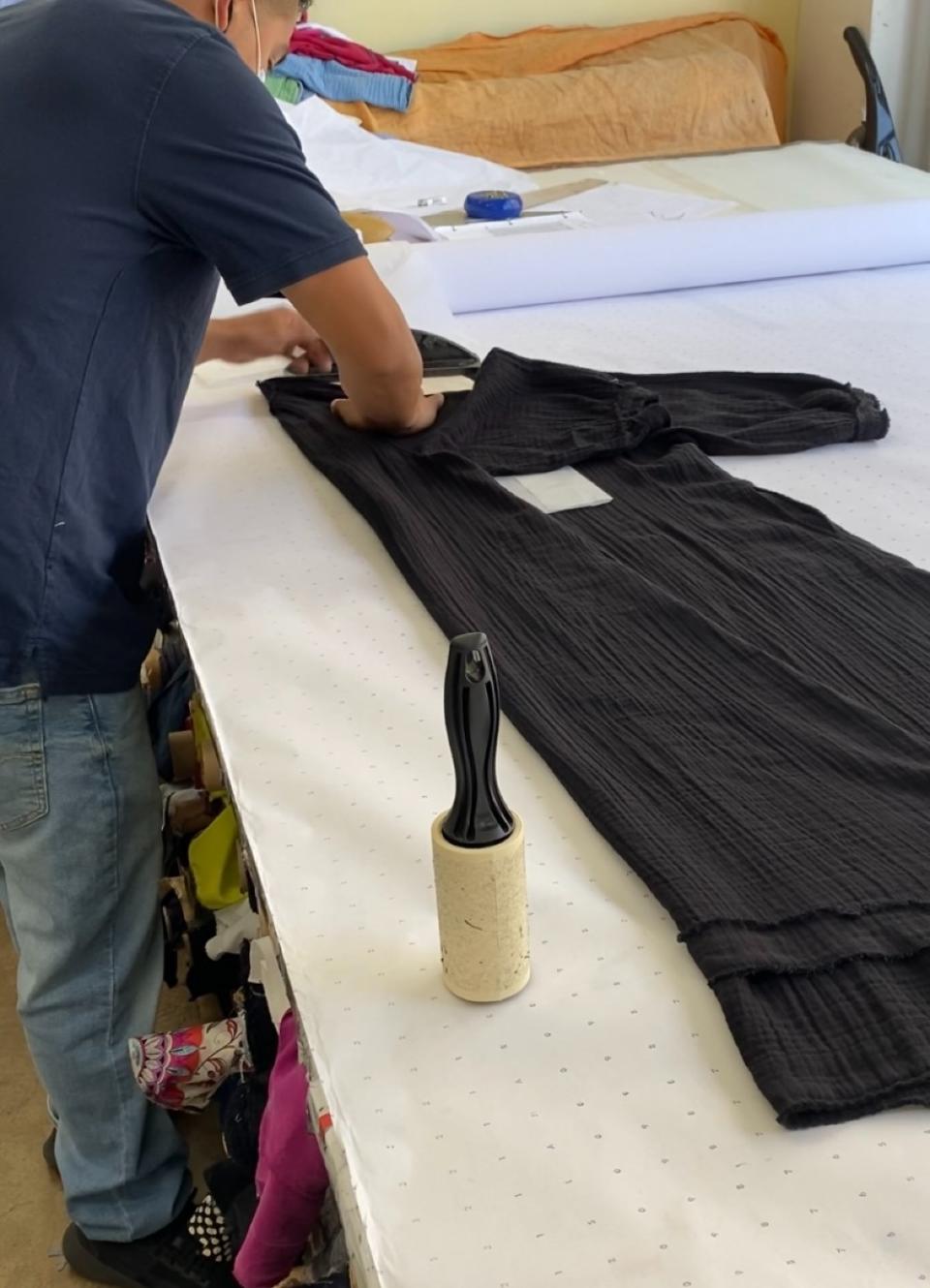Rezoning Proposal Puts Historic L.A. Fashion District in Peril

Click here to read the full article.
The growing disconnect between the workers and manufacturers that produce goods in the U.S. and the decision-makers who govern has put an iconic slice of American industry in jeopardy.
Today, garment workers will take to the streets and march on City Hall to defend Los Angeles’ century-old Fashion District—100 blocks of apparel and footwear factories, fabric mills, trims manufacturers, design studios, warehouses and retail spaces dating back to the early 1900s. The autonomous industrial center, which houses the largest, densest population of fashion industry workers in the country, is under threat due to a controversial rezoning proposal which will likely come to a vote next week.
The DTLA 2040 Community Plan presents a series of new zoning regulations designed to redirect the growth of Downtown L.A. over the course of the next 20 years, with an eye toward addressing the area’s housing shortage. Commissioned by the City Council, seven versions of the plan have been batted around L.A. City Planning over the course of the past nine years. The most recent draft awaits approval from the City Council Planning and Land Use Management Committee (PLUM), with a time-to-act deadline of May 12.
Under the plan, land use designations within the Fashion District would evolve from mostly manufacturing to include “a wide range of housing types and commercial” applications, from apartment buildings and condos to breweries, shops, theaters and offices. Today, much of the Fashion District is zoned for light manufacturing, like fabric and garment production, as well as warehousing, offices, and other job-generating businesses. Residential use is permitted only within existing buildings situated on the Western side, and not at all in the Eastern zones where heavier industrial activity takes place.
The city’s plan would open up much of the Western lobe of the Fashion District to residential development, with some areas zoned for retail and other commercial use. It would place limits on the size of ground-floor operations between Broadway and Maple Ave., prohibiting large-scale textile and apparel manufacturing businesses from opening. Where housing is currently permitted in existing buildings between Maple Ave. and Crocket St., new developments will only be required to reserve “approximately one story for job productive uses such as office or apparel manufacturing.”
L.A.’s 67,000-strong fashion creative sector includes 25,726 apparel workers, 4,266 fabric makers and 2,875 leatherworkers, among others, according to Otis College’s 2023 report on the creative economy in California. The vast majority of those employed by this $9.7 billion industry reside Downtown. They live and work in an interconnected community that represents the country’s most productive verticalized fashion manufacturing hub, producing fabrics, trims, finished goods, accessories and cosmetics.
Both “a historic and an active ecosystem for the U.S. garment industry,” Downtown L.A. is “the capital of garment production in the U.S.,” according to Marissa Nuncio, director of regional worker rights group the Garment Worker Center (GWC). The Fashion District is responsible for about 83 percent of the country’s apparel production, far outpacing its better-known sister district in New York. As of 2019, L.A. housed 58 percent of all registered fashion contractors in the U.S., city data shows.
The neighborhood’s founding is credited to Morris Cohn, a German immigrant whose East 12th St. menswear factory is now an official historical monument marking the center of the Fashion District. The area was known as the Garment District until the mid-1990s, when a collective of local property owners created the L.A. Fashion District Business Improvement District and spearheaded a rebrand to reflect the diverse industries that had come to call it home. Today, the Fashion District houses more than 5,000 businesses, including about 2,000 wholesalers selling everything from streetwear to sneakers, handbags, hosiery, lingerie and bridal gowns.
Nuncio fears the industry dilution that would come with rezoning. “Our biggest concern is that [DTLA 2040] would change land use designations to prioritize market and hybrid uses over light manufacturing in this district,” allowing developers to sweep through with plans for hotels and high-priced condos, she said. “That would displace the garment manufacturers that are there, and therefore the jobs that are there.”

The GWC would like to see garment manufacturing remain prioritized throughout the district, and see the city work to preserve the integrity of active businesses with protections and incentives. Industry operations are not currently bolstered by tax breaks or subsidies in the Fashion District, or any part of L.A., the group said.
But legislators are clamoring to address the city’s housing crisis, with rents and home costs skyrocketing due to myriad factors, including heightened inflation. The explosion of homelessness, especially Downtown, has become dire, with incoming Mayor Karen Bass declaring the issue a state of emergency on her first day in office in December. The DTLA 2040 plan nearly doubles the area where housing is permitted in Downtown districts, from 33 percent to around 60 percent, and is slated to account for 20 percent of L.A.’s overall housing growth over the next two decades.
Nuncio believes the proposal to augment the Fashion District’s housing capacity isn’t nearly nuanced enough. “To the extent that this plan would include housing development, our position is that we need to be very protective” of existing industry, as L.A.’s designations for affordable housing have proven beyond reach for most garment workers. “The housing that has so far been developed [within the District] is often market- or luxury-rate, and not affordable to our members,” Nuncio added. About 65 percent of the GWC’s 300 dues-paying members are women, many of whom live between 10 and 20 minutes by foot or public transit from their workplaces in the areas surrounding the Fashion District.
The DTLA 2040 push “sets off the beginning of a systematic erasure of identity” for the Fashion District, imperiling a vital element of the city’s economy and history, according to Better World Group’s Irene Takako Farr, an expert in urban planning engaged with the GWC campaign.
The area “is very reliant on this network of businesses working together through knowledge and materials exchange,” and compromising the city’s seamless supply chain will hamper the industry’s resilience, she said. The consultancy’s research showed that most buildings in the Fashion District currently dedicate 60 percent or more of available space to manufacturing operations, with the remainder used for offices, retail and parking.
By contrast, the city’s proposal stipulates that only about 12 percent of new development must be dedicated to manufacturing, setting the stage for competitors to begin pricing out longstanding businesses benefiting from the current zoning, Takako Farr said. “L.A. City Planning had done a lot of outreach to property owners and landlords while developing the first draft of this plan,” but has largely neglected to consider employers or their workforces, she added.
“Factories are already moving further and further away because of large developers investing a lot in the displacement of this district,” garment worker and GWC member Apolinar Mancilla told Sourcing Journal, noting that employers have decamped to East L.A. or Long Beach in search of cheaper rent. For many garment workers who reside Downtown and don’t own cars, commuting that far is a near impossibility.
“One example I heard from an employer was that he was paying $3,000 a month to rent a location, and now they’re asking $7,000 a month for the same location,” GWC member Francisco Mancilla added. Subverting or driving out garment manufacturers “seems to be a subliminal goal of this plan,” he said, noting that incoming developers are routinely removing freight elevators necessary for industrial work from the buildings they’re buying, rendering them unfit for industry use. The GWC is pushing the city to require developers to preserve these features, including loading docks and loading bays, within and surrounding buildings occupied by garment manufacturing.
“The Fashion District has been the engine for garment production in L.A. for years, and this plan is going to impact thousands of us,” Mancilla added. “The consequences will be grave” for the area’s workers, many of whom have been a part of the industry for decades, he believes. “We need support from our council members. We need their votes so that we can make changes to this plan and allow garment work to stay.”

The proposed rezoning of the Fashion District mirrors the city’s revitalization campaign for the Downtown Arts District, which saw an area claimed by impoverished artists in the 1960s and ‘70s become a hotbed of development when it was rezoned to include more live-work and residential uses in the early 2000s. The explosion of new housing led to an influx of retail, offices, restaurants and bars, and building in the area has not slowed for nearly two decades. Sweden-based construction firm Skansa is currently erecting a 15-story, 290,900-square-foot office and retail building—a redevelopment of two industrial buildings that it purchased in 2020 for $18.9 million. Takako Farr said the redevelopment of the Arts District resulted in the displacement of pre-existing industries and communities, and fears an analogous outcome for the Fashion District. The similarities between the two plans highlight a disconnect between the City Council’s understanding of garment work as a driver of L.A.’s economy, serving customers far beyond the city’s borders.
Mary Price, founder and creative director of the inclusive and sustainable label Ocean+Main, called domestic manufacturing a “pillar” of her eight-year-old womenswear brand. “There’s something so special about this ecosystem in Downtown L.A., and I’ve had the fortune of being able to produce all around the world,” as a merchandising director for global brands and retailers. “There’s nothing like this at this scale and this level of talent, with all the components that you need to build a brand.”
Price believes the City Council’s drive to rezone the Fashion District probably stems from the optics of the area. “People drive through this part of L.A. and see these buildings that they assume are dilapidated and empty,” she explained. “They don’t realize that they’re filled floor-to-ceiling with small businesses and services that do nothing but support garment manufacturing.”
Even locals are largely unaware of the bustling garment industry Downtown, as it’s tucked away in an enclave that few have the need to visit. “The big stories over the years have been about offshoring, with everyone shifting production overseas,” a perception that is reinforced at mass retail, where most clothing tags read “China” or “Vietnam,” Price said. “From a consumer perspective, that that’s all there is,” she added. “It’s like this industry doesn’t exist, because no one has really promoted the fact that it’s the number two creative economy and the number two manufacturing economy in the city.”
But rumblings about the benefits and potential of onshoring have been growing louder in recent years, following the supply chain turmoil of the Covid era and the simmering geopolitical tensions that continue to threaten international trade.
“More and more brands are looking to have a component of their manufacturing base here,” Price said. Proximity to those operations is vital to her business, with Ocean+Main’s dresses and caftans made within a block of its design studio by four independent contractors renting small production spaces. “The control I have over the product, the quality, the timing of delivery—I lose all of that by going overseas.” Offshoring would in fact be cost-prohibitive due to high MOQs, freight and duties, she said.

Price took the initiative to voice her own reservations about DTLA 2040 to City Planning. “I felt like they were surprised to learn the magnitude of the business here,” she said. “Do I feel like that we carry the weight and the gravitas of a real estate developer? I don’t think our voice is as loud as that.”
The Fashion District may also be fighting against preconceptions about the industry itself, Price believes. “It’s a very analog business—we can’t digitize it,” she said. In the 21st century, that makes investment a lot less sexy. “People might see it as ‘just clothes’—this vain industry that’s not really real.” If Downtown manufacturers were building semiconductors instead of shirts, software rather than soft goods, the story might be different.
Far from a one-sided issue, the near-term future of the plan is murky. City Planning told Sourcing Journal that it has been conducting outreach since the first iteration of the DTLA 2040 Plan took shape in 2014. Numerous fashion district stakeholders expressed support for a greater mix of uses, including housing, it said.
The department only began engaging with local businesses and garment worker advocacy groups, including GWC, in late 2021, however, with official meetings taking place in January and February of last year. In response to their concerns, an outside consultant was brought on to conduct an economic analysis weighing the Plan’s effects on the garment industry. The feedback was definitive. “The proposed Industrial-Mixed and Commercial-Mixed use districts, which permit residential uses in parts of the Fashion District as part of [DTLA 2040], may facilitate redevelopment or reuse of non-residential buildings in the area, risking displacement of those buildings’ tenants in the process.”
City Planning proposed modifications to its original plan following the assessment, including prohibiting existing non-residential buildings in the core of the Fashion District from being converted to residences or hotels, and rewarding new building projects that incorporate 50 percent or more manufacturing space with development bonuses. It also recommended a graduated inclusionary housing program that would make affordable housing more attainable to the lowest earners. Those modifications were sent to PLUM in September. After receiving the proposed changes, the City Council must vote on whether the original Fashion District plan will be amended, or voted upon as it originally stood.
Either way, the industry will have its answers within weeks. But for some, displacement is already becoming a fact of life.
After eight years in her Downtown factory space, Marta Miller, founder of womenswear supplier Lefty Production Co., was informed in March that the building had been sold to a developer intent on retrofitting the structure for housing over the course of the next two years. Erected by a family-owned garment business 99 years ago, the space has housed similar operations ever since.
Lefty, which crafts goods like swimwear and loungewear for national brands and California startups, was among the suppliers that answered former L.A. Mayor Eric Garcetti’s call to create masks and gowns for overburdened regional hospitals during the Covid crisis. Three years later, its fate hangs in the balance.
“You have a building that’s been making clothes for a century, and now there’s going to be no productivity coming out of it,” Miller said. With rents on the rise along with the overall cost of doing business in the state, the factory owner said that the DTLA 2040 plan would be yet another push toward greener pastures. Lefty purchased an ancillary manufacturing business in Austin early last year, and the factory owner anticipates “shifting more of the business to the Texas side” as she weighs her options for the future.
While the loss of the production space will have a material impact on the business, Miller is intent on keeping a foot in the Fashion District. “I will still have a presence in L.A., of course,” she said, though she’s not sure yet what that will look like. “I’m not the only business owner going through this,” she added. “People figure things out.”
There’s a unique symbiosis to the industry Downtown, and it’s a benefit that is impossible for her to discount. “We can walk down the street and get our elastic, go a little further and get our swim fabric and around the corner to get our marker paper,” she said. “It’s all right there, and it’s hard to re-create all of that.”

